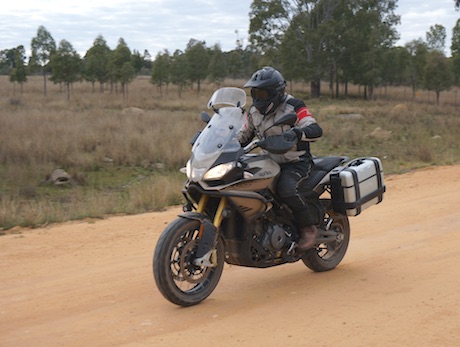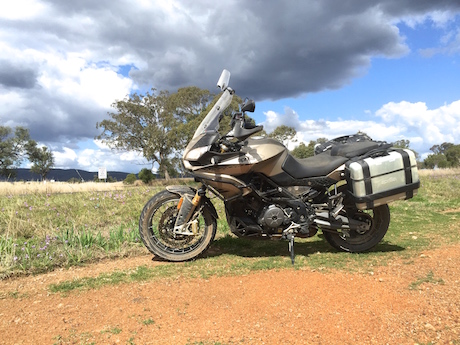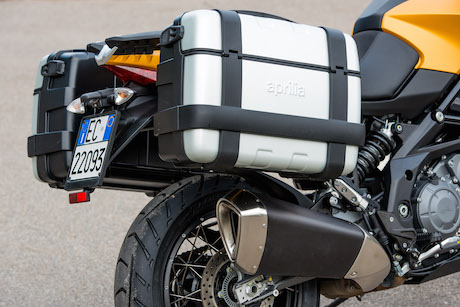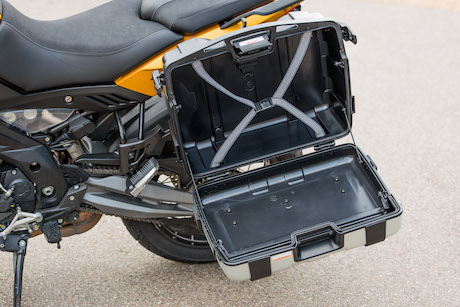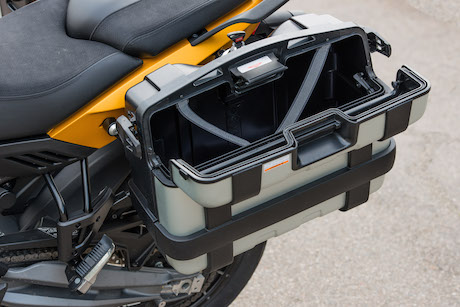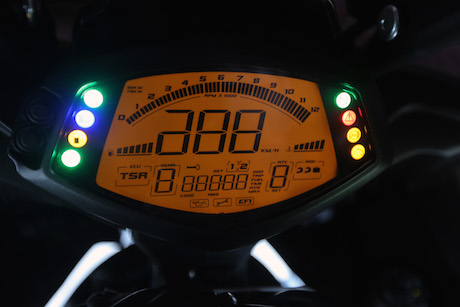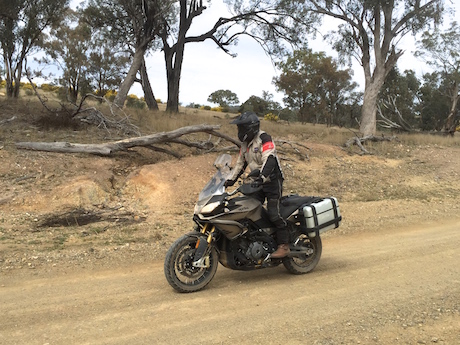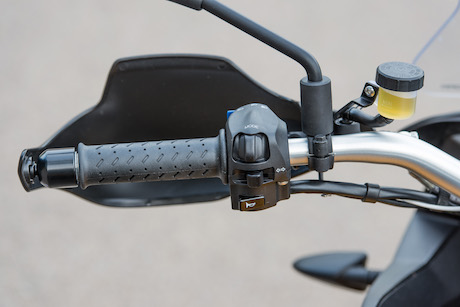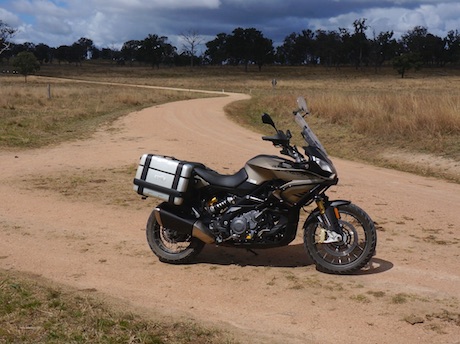The big-bore adventure market is booming with high-tech, high-powered bikes and now the Aprilia 1200 Caponord has seriously thrown down the gauntlet to the BMW king with its dirt-aggressive Rally model.
The hi-tech Rally arrives at $24,000 ride away. If you compare that on paper with prices of its competitors it looks expensive, but this one has all the “fruit” including luggage while most of the others often charge way more for the same level of equipment.
The Rally comes standard with ride-by-wore throttle, electronic adjustable suspension, cruise control, three engine maps, three-level traction control, lockable aluminium panniers, adjustable touring windscreen, hand guards, side guards and supplementary LED lights. It’s a comprehensive list, but surprisingly doesn’t include grip warmers or self-cancelling indicators.
It’s also easily the most attractive big-bore adventurer around.
Italian fans may say it’s a toss-up with the Ducati Multistrada and the Moto Guzzi Stelvio, but it’s a very handsome and tidy design. Even the protection bars integrate pleasantly with the lines, unlike some other adventurers.
The Multistrada is the most powerful in the big-bore range, but the liquid-cooled 1197cc V-twin in the Aprilia has as much power as the market-leading BMW R 1200 GS, if a little less torque.
However, on the road, it feels far more like a rocketship than the new liquid-cooled 170cc boxer Beemer, despite being a 24-litre tank full of fuel heavier. That’s about 17kg and the reason we went through that little exercise is that Aprilia only supplies the dry weight of the bike at 238kg.
The midrange oomph is exceptional and it spins up to dizzying heights without any breathlessness, all the while delivering one of the best harmonies of warm Italian sucking and blowing I’ve heard.
You wouldn’t change the exhaust for a better note; maybe only to remove the unsightly, bulky and heavy stainless steel muffler or for a couple of extra ponies.
The Caponord Rally comes with more dirt aggression and touring capacity than the standard model thanks to its 19-inch spoked front wheel which replaces the 17-inch mag wheel, and the inclusion of luggage, screen, lights and various guards.
Like the BMW, they have cleverly threaded the spokes outside the wheel rims so you can run tubeless tyres, however these rims look much sturdier and capable of taking bigger hits such as cattle grids.
The luggage is sturdy, with clever double-opening panniers that either work as one big door, or just the top section.
Side-opening luggage allows you to access bulky items, but is a nuisance as they spill the contents over the road when you open them. Top opening is convenient for grabbing small items on top of your luggage. This is the best of both worlds!
However, the panniers can’t be opened without the ignition key, which is good for security, but a nuisance. There are also three latches required to open the case which is a bit unnecessary. However, if you’ve ever had your luggage fall open over a bumpy road, you’ll be glad of the extra security.
The windscreen is big and easy to adjust, but in any position it seems to direct buffeting at my head, so I added a windscreen extension which solved the problem.
I didn’t expect the Rally extras to make this such a good touring adventurer.
I thought it would be more tar-oriented than the BMW or KTM, mainly because of its electronics package. I was wrong.
There may be no specific “off-road” or “enduro” settings, but you can adjust the three traction control levels or switch it off altogether, switch off the ABS, use the “rain” engine mode and set the suspension adjustment to auto so it adjusts for the terrain.
With traction and ABS off, throttle response softened and the auto suspension setting, it becomes a very capable on dirt roads. I’d say it’s just as good as the BMW.
I thought the suspension would be too stiff for bumpy sections and the steering too light and flighty, but I was surprised at how planted it felt.
The only drawback on traction was the standard Metzeler Tourance tyres, but even they were quite good on hard-packed granite and dry clay.
In fact, the only limiting off-road factor is the high gearing, however you could easily change one or both sprockets to gear it lower.
I chose the “rain” engine mode on slippery gravel surfaces to soften the throttle response and turned the traction control to 1.
You can also turn it off, but it’s not an easy exercise: you need to hold down the toggle button which changes the levels settings between 1 and 3 on the dashboard and while on the 1 setting, press and hold the toggle down for a few seconds until you get a negative symbol. To bring the system back on, hold the same toggle button for a few seconds.
Anyway, I found for most dirt situations, the 1 setting was fine, allowing a bit of spin and tail-flick, but not letting it get out of control.
You can adjust the dynamic damping suspension for one or two riders, with or without luggage, or choose the automatic setting which will adjust for the load and keep the bike fairly level.
Around town, the bike feels light and manoeuvrable and the non-adjustable 840mm narrow seat allows this 187cm-tall rider to easily put both feet flat on the ground when stopped.
When standing, it is much narrower than the big Beemer and the whole bike feels much, much smaller than a 1200.
I rotated the high-bend bars forward and they felt quite comfortable when standing with no need for expensive aftermarket risers.
However, the wide bars and prominent luggage make lane filtering a bit tricky for commuting and it surges annoyingly at low speed on constant throttle.
In case of emergency, you can rely on the big Brembo brakes. They have plenty of urgency, but also a lot of feel for trailing brakes in corners or at slow commuter speeds thanks to the steel braided hoses.
Back on the highway, the Rally will roll along at 100km/h in sixth gear at 4000 revs and easily overtake with just a roll of the throttle, rather than the need to swap down cogs.
However, if you do, the Italian accent from the exhaust and the urgent thrust from the engine are most rewarding.
If you settle into the highway rhythm and use the cruise control, you may become very frustrated. It’s the same control used on other Aprilia and Moto Guzzi models and it is a nuisance.
It’s just one button and to turn it on, you hold it for several seconds which is difficult while also trying to hold the throttle steady.
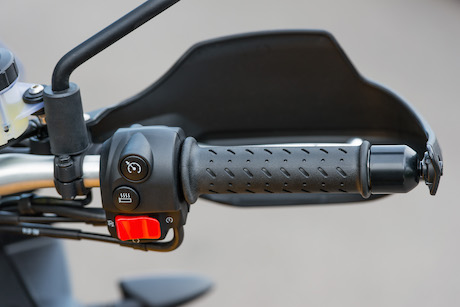
Once turned on, setting the cruise is tricky. Sometimes it works, but you have to keep stabbing at it while trying to control the throttle. I could never get it at just the right speed.
Once set, it drops several km/h, then gradually increases and steadies out at somewhere near where you wanted. There is also no adjustment to increase or decrease once it is set.
While the cruise control is oversimplified, the other switches are too numerous.
There are separate mode switches for information on the left handlebar, two buttons on the instruments for setting the ABS, traction control and suspension, and you use the ignition switch to set the engine maps.
Aprilia needs to rationalise this set-up, reduce the number of switches and make the whole system more intuitive. As it is, it is almost impossible to remember how to use the various switches.
We took the Rally on a 1000km trip out west over a variety of dirt, gravel and clay roads as well as bumpy country tar and found it quite capable and comfortable as a 50/50 tar and dirt adventure tourer.
The seat is very comfortable for several hours of riding or until the tank runs out.
Not that you will let it run out, because the over-cautious gauge quickly drops to one bar at around 250km, urging you to find a servo. When I filled it up, I found there was still seven litres left in the tank!
Fuel economy varied from a low of around 6L/100 to just over 7L/100km which is a bit high but I wasn’t really riding for economy and the engine on the test bike is still new.
There is a fair amount of heat coming out of the engine, especially on the left side, which would be uncomfortable in summer, especially at slow speeds. At highway speeds, it’s negligible.
Some may not like the fact that it has a chain instead of a shaft. It also doesn’t come with a centre stand for cleaning and servicing your chain.
There is a good variety of accessories you can buy for the Rally including wider footpegs (the standard pegs are fine and come with a removable rubber inset), a bigger side stand footprint, quickly-detachable top box, heated grips, comfort and sport seats, Arrow exhaust and tank bags.
I had pre-judged the Rally based on the standard Caponord and was pleasantly surprised at how competent it actually is as a dirt adventurer.
It’s also very much at home on a twisty piece of tar with big lean angles and grippy rubber and is a most capable two-up tourer with a rear rack to easily attach a top box, a comfortable rear seat and a long reach to the footpegs.
If you don’t want to follow the herd, but still want an adventure bike with plenty of punch, good looks, touring comfort and dirt capability, you really should consider the Aprilia.
I’ve owned several GS models and I believe the Rally is more than a match for the market-leading GS.
Aprilia Caponord 1200 Rally
- Price: $24,000 ride away
- Engine: 90° V-Twin 4 stroke, liquid-cooled, DOHC, 4 valves per cylinder, 1197cc
- Power: 92kW (125hp)
- Torque: 115Nm
- Bore x stroke: 106 x 67.8mm
- Compression: 12:1
- Transmission: 6 Speed
- Brakes: Dual 320mm floating stainless steel rotors, dual Brembo 4 spot Monobloc radial mounted calipers, stainless steel braided brake lines; 240mm stainless steel rotor, Brembo single spot floating caliper, ABS
- Chassis: Modular tubular steel, removable steel rear sub frame.
- Suspension: Fully adjustable electronic Sachs 43mm upside-down fork (hydraulic compression and rebound damping electronically managed with Aprilia Dynamic Damping; Fully adjustable Sachs dynamic rear monoshock (spring preload and hydraulic compression and rebound damping electronically managed)
- Wheels: 3.0 x 19”; 4.5 x 17” spoked
- Tyres: tubeless 120/70-R19; 170/60-R17 Metzeler Tourance
- Dry weight: 238kg
- Seat: 840mm
- Length: 2280mm
- Height: 1475mm
- Wheelbase: 1575mm
- Trail: 118mm
- Steering Angle 27.4°
- Tank: 24L (5L reserve)
- Economy 6.6L/100km tested
- Range: 350km+
- Colours: golden “Gallio Dune” or matte grey “Grigio Safari”


